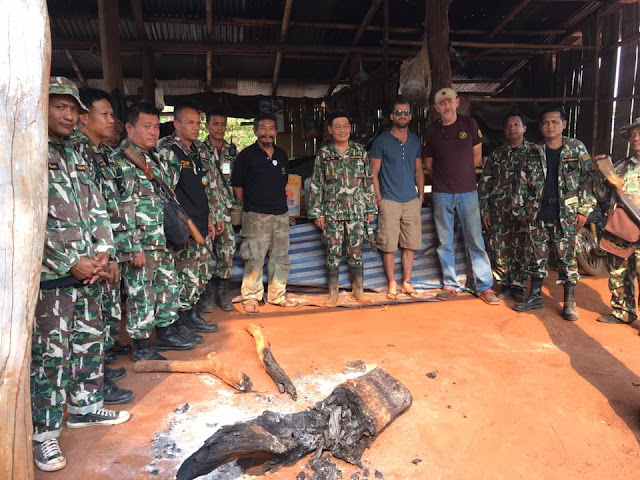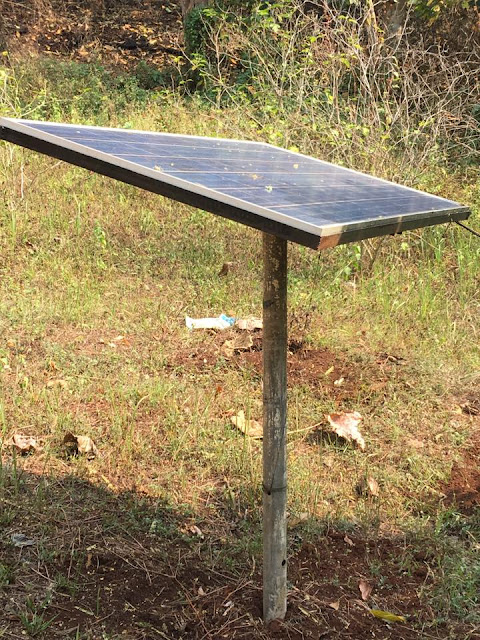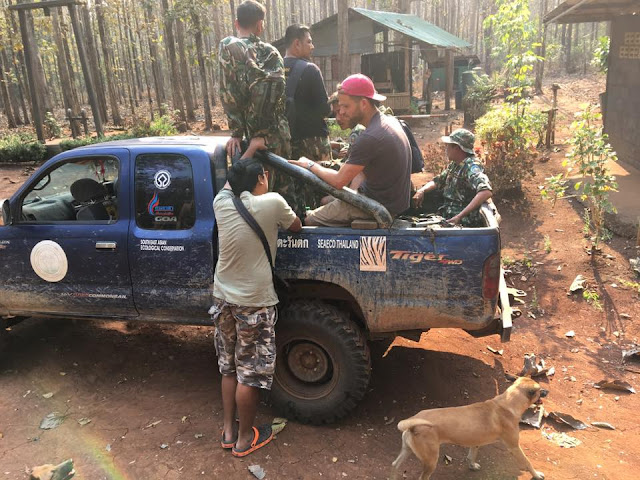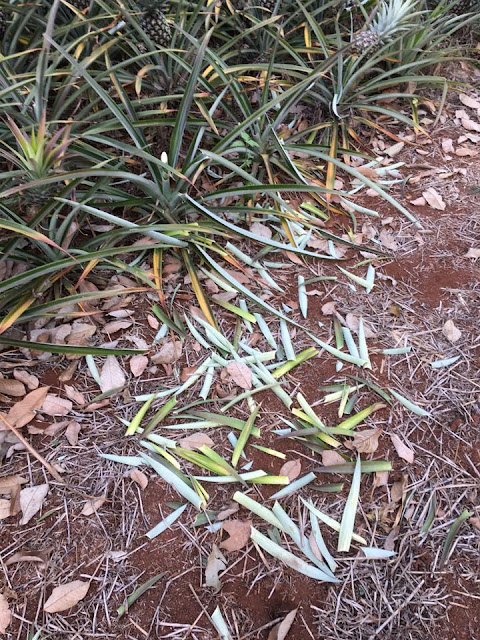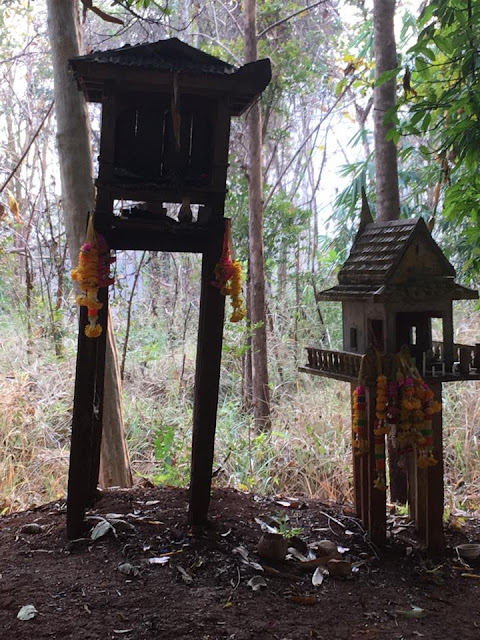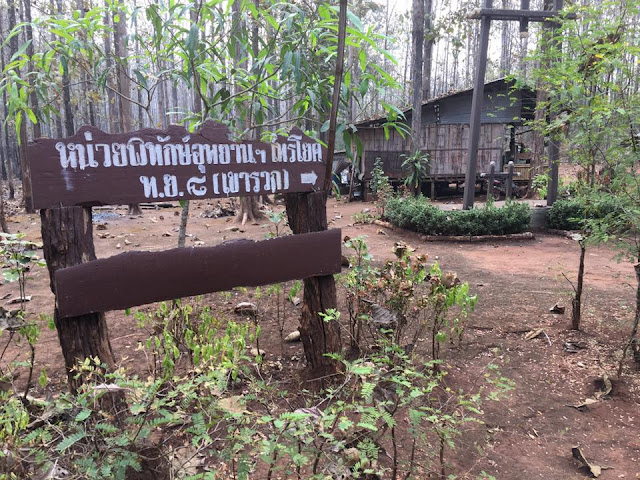Sunday, March 12, 2017
A an old sign at the summit of Khao Ruak being swallowed by the tree.
Mai Yuk Ranger Station- Thong Pha Phum National Park — with Ádám Molnár.
A small project that FWFCC and Seaeco had earlier initiated was the purchase and installation of a solar panel and batteries for Rangers at the Mai Yuk Station. Previously there had been no lights or way to charge cell phones.
We've arrived near where the incident took place. A few old growth trees from the old growth forest remain in local village farms, now mostly planted with pineapple and rubber trees.
The incident occurred in the early evening. Several elephants were walking around and near the open style Karen bamboo house. The couple staying there were afraid and decided to make a run...it was a mistake. This photo was taken near the neighboring house where the elderly woman ran for safety. She was met by a mother elephant and baby, the mother, in defense, gave a swift and powerful kick. In the foreground you'll notice a light area of soil where the mother elephant placed her powerful kick, ending the woman's life.
Our trusty truck-Moonliner winds its way up the Khao Ruak Road, a steep, rocky, treacherous, rutted and dry road. It becomes a nightmare if it rains. Signs of elephants...yep one big dung pile. — with Ádám Molnár.
Several kilometers into the forest, we've stopped at the Khao Ruak Ranger Station and delivered drinking water. During the dry season, water is difficult to find. My good friend Ádám Molnár had recently arrived from Hungary. — with Ádám Molnár.
One bite at the stem and the pineapple is free and the leaves removed. It's going to be a bigger problem next year as the elephants will return..."memory of an elephant" is real and next year they will eat the entire crop. So, what to do? Likely the best solution is to change the crop, but being used to doing things a certain way, makes it more difficult to change people's views, ideas and ways.
Fresh elephant tracks...likely from last night. Pineapples here were just harvested, so the tracks are easy to see in newly turned soil.
On the top of the mountain, the Khao Ruak Forest Protection Shrine, we stop and pay respect.
It's the dry season and the elephants are looking for two things...over 200 liters of water per day per full grown elephant and of course food. Many cisterns in the neighboring rubber plantations are destroyed in their search for water. Ultimately, this crop of pineapples is tasty and perfect for them. Already they have trampled some of the plants and have begun eating. No doubt they'll be back tonight.
"Just a taste" or perhaps a heavy side step, this ranger takes a look...
A fallen tree allows little room for our truck and passengers to slide through. Note the single trail on this so called Road, single because of only motorcycle traffic. No recent signs of 4 wheel traffic...
Formerly Plantation, this area, as well as what's ahead of us, was assigned to Sai Yok National Park several years ago
We've returned the following day with food and drinking water to support Rangers from Sai Yok National Park, Thong Pha Phum National Park and a Forest Protection Unit from the Royal Forestry Department. One ranger shows me a photo of a ferocious male elephant who has overturned a vehicle. They are identified by their ear patterns, this one has a hole in its ear. And now these experienced Rangers ... See more — with Ádám Molnár.
Tuesday, February 21, 2017
 During 19 - 23 March, 2008, WFCC headed north to carry out the 180 feet Radio Tower onstruction Porject for the radio net controll station of Thungyai Naresuan wildlife sanctuary(east) at its head office in Tak province as requested by chief Sompong Thongseekhem, superintendent of the wildlife sanctuary due to its radio tower accidentally had collapsed down causing by the hit of one big tree branch that fell down and broke the northern tensioned cable of the 180 feet guy wire radio tower which not only damaged the tall radio tower itself but also its head office building both inside and out side as well.
During 19 - 23 March, 2008, WFCC headed north to carry out the 180 feet Radio Tower onstruction Porject for the radio net controll station of Thungyai Naresuan wildlife sanctuary(east) at its head office in Tak province as requested by chief Sompong Thongseekhem, superintendent of the wildlife sanctuary due to its radio tower accidentally had collapsed down causing by the hit of one big tree branch that fell down and broke the northern tensioned cable of the 180 feet guy wire radio tower which not only damaged the tall radio tower itself but also its head office building both inside and out side as well.As this radio tower is a crucial structure of the radio net controll of the wildlife sanctuary at its head office that operates Thungyai east frequency of both receiving and transmeitting routine daily and urgent messages to its network radio stations that spread through the huge area of the great forest, hence, WFCC promptly listed the Radio Tower Construction Project for Thungyai east in its urgent project list.
Then WFCC hurridly speed up all the processes and the construction mission from the examining and evaluating the project and all possible solutions, repairing the damage radio sections and producing the new noes, the redesign of the new guy wire radio tower, the acquistions of new antennas, cable, wire, turn buckets and all other needed construction material, tools, equipments, supplies, etc., to the final stage of the construction mission of the new radio tower and its system that started from late January 2008, till the urgently needed risk-taking porject completed on Marh 23, 2008, totalling effort and time input in this endeavour project is all about 60 days.
On March 18, 2008, when all every task of the preparation process finished, WFCC then, headed north to carry out its 7 days mission, the las stage of the construction of the new radio tower for Thungyai Naresuan wildlife sanctuary(east),
participating by officials and rangers of the wildlife sanctuary and WFCC that accompanying with Mr.David Kucera, Checz Republic, who also collaborated in this mission and redered the financial support to the patrolling of Thungyai rangers on behalf of The Checz Republic as proposed and organized by WFCC.
Many hours of tough driving through 1,219 curves along the long and winding 'Road of Death' to Um Phang till the wildlife sanctuary, many burning fields set by hill tribe farmers as the primitive method of land preparation for the coming planting season that caused more global warming were spotted in the vast area along the raod sides. And after 4 hard and risky days of the endeavor project passed, finally the new 180 feet guy wire radio tower had successfully erected at its original spot with 2 new dipole antennas and coaxial cable installed which wired with more tensioned cables installed than before so that to strengthen the tall radio tower even more.
And when the radio net controller could retrive all the potentialities of his radio station, the center radio station of Thungyai Naresuan wildlife sanctaury(east), that efficiently responsed to all dimentions of the routine daily operations of this immense radio station which reinforce and back up all its rangers through its network stations that spread and cover the huge area of this pristine forest in their crucial patrolling to protect the priceless nature and wildlife of the great natural world heritage forest, then WFCC retreated back through the "Road of Death" to its stronghold fortification and ended up its another urgent and significant project, as the 1,600 Km. mission was totally completed.



D530307: Radio Tower Construction Project for Thungyai East's HQ., a set on Flickr.
 Traveling in the north to see the rare Sarus Cranes. If you're interested in wildlife, take a look, I'll be posting more. David Butler | 19 Feb 2017
Traveling in the north to see the rare Sarus Cranes. If you're interested in wildlife, take a look, I'll be posting more. David Butler | 19 Feb 2017Several days ago, members of SEAECO and FWFCC arrived in Buriram Thailand at the Sanambin Reservoir Non-Hunting Area in hopes of getting a glimpse of the rare and endangered Eastern Sarus Crane (Grus Antigone). In just two days we've had quite an experience. — with Surin Binnan.
Our guide, expert, long-time wildlife researcher and good friend Hinpha Pranprai (Neung) spends his valuable time educating us on the history, habitats and habits of Thailand's Eastern Sarus Cranes. He's likely one of the foremost experts on these Cranes. We're hoping to get a chance to see some. Neung is currently the head of production for CTV Bura Bha Co. Ltd. which will very shortly be airing a special production on the Sarus Crane.
My first view of a pair of Sarus Cranes from a far-off tower...center right is the female and through binoculars we could see her in the process of building her nest and then practicing sitting on the nest which she will soon complete. Center left, the male actually danced for us. Once completed, she will install horizontally at the bottom of the nest, several hollow twigs which will make the nest float when the monsoons arrive. She will give birth in the coming months. They are extremely shy, have keen vision, (they can see up to 500 meters away), so even from a great distance any sudden movement can alarm them. Thailands' population in the wild stands at only 38 individual birds.
As we approached the 2nd nest, I was well aware of my iPhone's limitations and by pure luck (and with very little skill, I might add )-: ), I managed to get a shot through the binoculars! You can see it's head against the green tree background. The Saras Crane is the tallest flying bird in the world with males growing up to nearly 6' tall. Like other cranes, they mate for life and in the event of one partner's death, the other will starve itself to death. This is likely one big factor for their ultimate demise in the wild. Predators include hawks and snakes, including the huge Burmese Python.
A small road surrounds the marshlands where these non migrating cranes live. If you stop, they immediately fly away, so I got these two lucky shots on a drive by... The male on the left and female on the right with a baby (barely visible) in between.
You can see in this pic, the small baby crane standing off to the right of the adult. What makes this baby crane unique is that it's been Thailand's first Sarus Crane born in the wild. The baby's name is "Coconut". 20 years ago only 4 pairs remained in captivity, with 3 pair owned by the King of Thailand and one more pair in the Korat Zoo. In the wild, this crane was extinct and so began a long process of reintroducing the Sarus Crane back into the wild. SEAECO and FWFCC have been so fortunate to get this close, but wait, stay tuned, more to come...
Thursday, March 3, 2011
May 12, 2010: At the head office of Thungyai Naresuan wildlife sanctuary, FWFCC performed the handover of The Solar System Construction Project that WFCC had carried out its construction & installation of the solar renewable energy system to every ranger station of the wildlife sanctuary during 2001-2006 which first started at Mae Kasa ranger station on December 24, 2001 just the day after the auspicious ritual ceremony of the finished reconstruction of The Hermit Shrine that WFCC designed and collaborated which hold high spiritual respects of all Thungyai officials and its rangers, and eventually ended up with the construction of 1 kilowatt solar system at Maharaja station in year 2006 on August 14.
Mr.Roengchai Prayoonvej, director of The Administrative Office of The Protected Forest Region 3, presided over as a chairperson of the handover ceremony accompanied by Mr.Urb Choeng-sa-ard, diredector of wildlife division and DNP officials, and Miss Weraya Ochakul, superintendent of Thungyai Naresuan wildlife sanctuary, and its officials & rangers while David Butler and Binnan, FWFCC co-founders, represented on behalf of FWFCC.
After the report stating of the Solar System Construction Project was done, the picture frame of the first tiger photo taken form the first Thungyai Tiger Research in year 2006 that driven by the organizing and supporting of WFCC which power by the renewable energy of this project was also handed to director Roengchai as a commemorative symbol of the handover of this project.
The benefits & signicances of the huge investment in time & bugget consuming project which WFCC had input its effort & endeavor carrying out one of its forestry infra structure project, actually the mandatory mechanism of all forests, that needed a strong determination and enormous will power to overcome all obstacles and barriers of all kinds of travelling conditions in all seasons and the series of the monsoons through the great mountainous pristine forest, that turned transportation missions of needed tools, equipments, supplies and tons of the construction materials along with other ranger patrol supplies e.g., equipments, food, medicine etc., to be "The Impossible Missions"
Could be apparently noticed by the various dimensions in operational effectiveness that driven by the renewable solar energy of all ranger stations that spreaded through the huge area of this great forest, which is still functioning and driving all electrical equipments, especially all its radio stations and the Hermit, the central radio communicative station, the net controll of Thungyai that WFCC also started its construction in year 2003, till nowadays.
The main target of all our attempts in this endeavor project aiming & resulting in better effectiveness of the ranger patrol of the the wildlife sanctuary both in preventive & protective aspects beside responding the mandatory project for the preparation of the Tiger Research Project that successfully followed later on as planned.
And the ultimate and utmost benefits of this project fall in better safeguarding the nature and wildlife of the world heritage forest for the sake of mankind and this fragile world.
Mr.Roengchai Prayoonvej, director of The Administrative Office of The Protected Forest Region 3, presided over as a chairperson of the handover ceremony accompanied by Mr.Urb Choeng-sa-ard, diredector of wildlife division and DNP officials, and Miss Weraya Ochakul, superintendent of Thungyai Naresuan wildlife sanctuary, and its officials & rangers while David Butler and Binnan, FWFCC co-founders, represented on behalf of FWFCC.
After the report stating of the Solar System Construction Project was done, the picture frame of the first tiger photo taken form the first Thungyai Tiger Research in year 2006 that driven by the organizing and supporting of WFCC which power by the renewable energy of this project was also handed to director Roengchai as a commemorative symbol of the handover of this project.
The benefits & signicances of the huge investment in time & bugget consuming project which WFCC had input its effort & endeavor carrying out one of its forestry infra structure project, actually the mandatory mechanism of all forests, that needed a strong determination and enormous will power to overcome all obstacles and barriers of all kinds of travelling conditions in all seasons and the series of the monsoons through the great mountainous pristine forest, that turned transportation missions of needed tools, equipments, supplies and tons of the construction materials along with other ranger patrol supplies e.g., equipments, food, medicine etc., to be "The Impossible Missions"
Could be apparently noticed by the various dimensions in operational effectiveness that driven by the renewable solar energy of all ranger stations that spreaded through the huge area of this great forest, which is still functioning and driving all electrical equipments, especially all its radio stations and the Hermit, the central radio communicative station, the net controll of Thungyai that WFCC also started its construction in year 2003, till nowadays.
The main target of all our attempts in this endeavor project aiming & resulting in better effectiveness of the ranger patrol of the the wildlife sanctuary both in preventive & protective aspects beside responding the mandatory project for the preparation of the Tiger Research Project that successfully followed later on as planned.
And the ultimate and utmost benefits of this project fall in better safeguarding the nature and wildlife of the world heritage forest for the sake of mankind and this fragile world.


